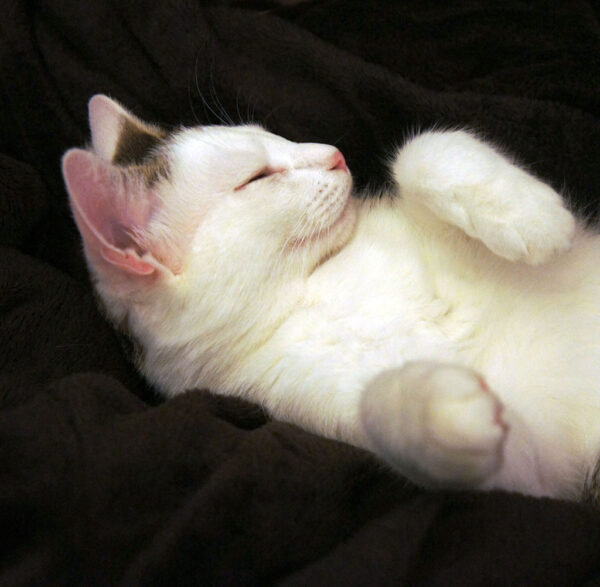
Cat Sleep Patterns
Cats are renowned for their tendency to sleep for extended periods throughout the day. Why do cats sleep so much? This behavior is not simply a preference but is deeply rooted in their biology and evolutionary history. Known for their efficiency in conserving energy, cats have adapted to sleep for an average of 12 to 16 hours per day. These cat sleep patterns can be attributed to their natural instincts as predators; in the wild, the need to hunt requires brief but intense bursts of energy, followed by rest periods to replenish.
In a domestic setting, a cat’s sleep cycle adjusts, but the love for sleep remains. While they may not need to hunt, domesticated cats still exhibit the same behavior of catching ‘prey’, which could just be a toy or a laser pointer dot. The domestic environment provides a safe space for cats to indulge in their lengthy slumbers without the threat of predators. Furthermore, as cats age, they tend to sleep more, largely because they need more rest to recover from their daily activities. Understanding a cat’s need for substantial sleep helps cat parents recognize the normalcy of this trait and ensures that they support their cat’s natural habits.
Key Takeaways
- Cats sleep up to 16 hours a day as part of their natural behavior.
- Their sleep habits are influenced by predatory instincts and domestication.
- Recognizing and supporting their need for sleep is essential for their well-being.
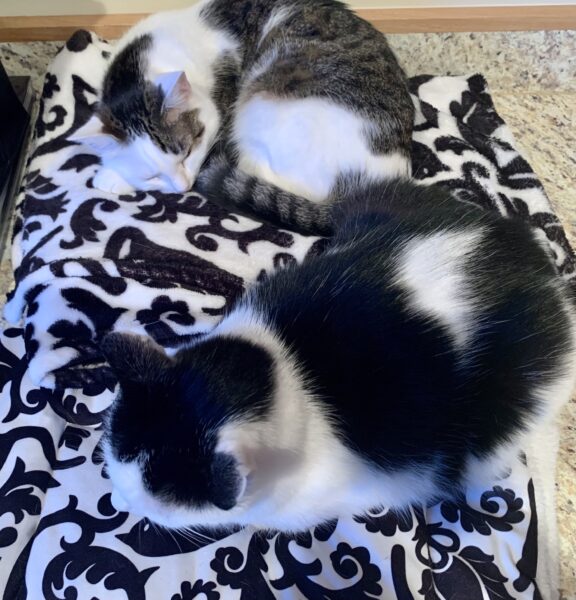
Cats’ Sleeping Habits
Cats’ sleeping habits serve both their physiological needs and instinctual behaviors. Various factors, such as age, breed, and lifestyle influence these routines, where sleep often aligns with energy conservation and predatory patterns.
Understanding Sleep Cycles
Cats experience sleep cycles much like humans, with periods of deep sleep and the rapid eye movement (REM) phase, where dreams typically occur. Deep sleep in cats is crucial for bodily restoration, while REM sleep may play a role in preserving memories and learned skills. Cats often alternate between brief catnaps and longer, restorative sleep cycles throughout the day.
Factors Influencing Sleep Duration
The duration of a cat’s sleep can depend on several elements:
- Age: Kittens and senior cats usually require more sleep compared to adult cats.
- Health: A healthy cat might sleep around 12-16 hours a day. Changes in sleep patterns can be indicative of health issues such as diabetes or kidney disease.
- Stress: Cats under stress may sleep more, using it as a coping mechanism.
Differences in Breeds
Some cat breeds have distinct sleep requirements. A Siamese, for instance, may exhibit different sleeping patterns when compared to a Persian, due to varying levels of activity and metabolism. However, these variations are often subtle and overshadowed by individual personality traits.
Natural Sleep Patterns
Cats are crepuscular—most active during dawn and dusk. This behavior traces back to their wild ancestors who hunted during these times to avoid stronger noontime heat and larger predators. Domestication has softened these patterns, but cats still often show spikes in activity during these periods.
Sleep and Health
Regular sleep is paramount for a cat’s health. Veterinarians affirm that disrupted or excessive sleep may be symptomatic of underlying health conditions like hyperthyroidism or stress. Conversely, a well-rested cat is typically alert and exhibits healthy behaviors.
Behavioral Aspects of Sleep
The cat’s ethology cannot be ignored when considering their sleep habits:
- Hunting Instincts: House cats conserve energy through sleep as if preparing for a hunt. Their natural predisposition to stalk and pounce on prey is deeply ingrained, despite the lack of actual hunting.
- Predator Awareness: Even while resting, cats remain alert to their surroundings, prepared to spring into action should a threat—or an opportunity—arise.
Understanding a cat’s sleep habits can offer insights into their well-being and help ensure they lead a content and healthy life.
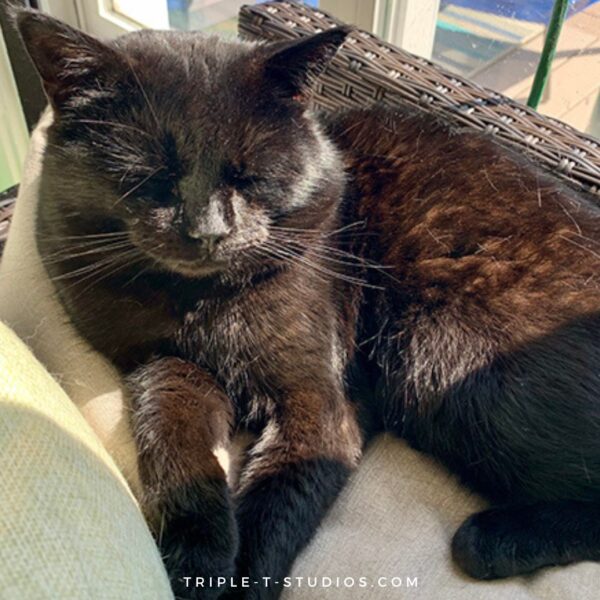
Interactions with Domestic Environment
Cats integrate into the home environment by finding favored rest areas and engaging in routines that balance play with their natural sleeping rhythms. Throughout the day, they exhibit periods of intense activity interspersed with rest, adapting to the household’s rhythm and space.
Common Sleeping Areas
Cats often select multiple sleeping spots within the home environment that offer comfort and security. The sofa often serves as a popular location where a cat might curl up for a snooze. Additionally, cats may choose sunny windowsills or even cozy corners near their owner’s feet. Placement of a cat bed or litter box nearby can influence their choice, as they prefer convenience for when they awake and need to be alert or use the facilities.
Playing and Exercise
Playtime is essential for a cat’s wellbeing, often marked by bursts of energy where they are fully engaged with cat toys. Owners might notice an increase in meowing or activity as a sign that their cat is seeking interaction or exercise. It’s important to provide a variety of toys to help maintain their physical health and combat boredom. Sessions of play are typically followed by periods of rest.
Daily Routine and Family Life
Cats develop a routine that syncs with the household’s daily activities. A cat parent might observe that their pet is most alert during early mornings or evenings, aligning with the family’s active hours. Cats also tend to adapt their sleep schedule to ensure they are awake and attentive during mealtimes or when family members are available for interaction. They may lick themselves clean after a meal or rest before becoming active again.
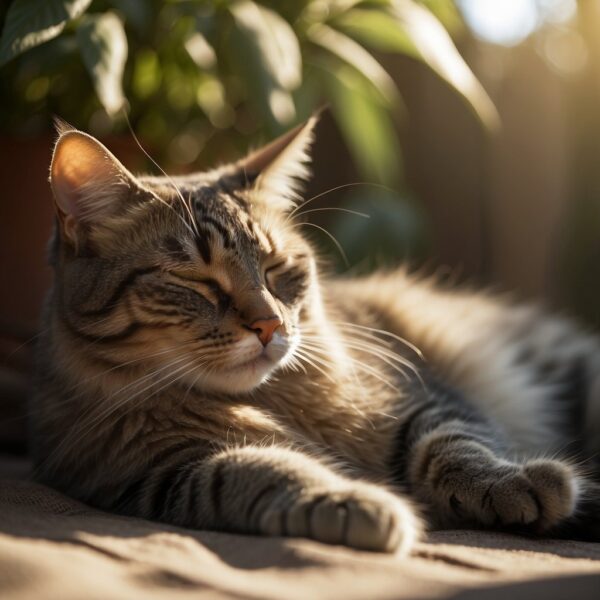
Physical and Psychological Health
Cats’ sleep patterns are often indicative of their overall health and well-being, with changes potentially signaling physical or psychological issues. Monitoring their behavior can provide insights into their health status.
Signs of Illness or Discomfort
A typical feline spends a significant amount of their day sleeping; however, excessive sleep—especially when coupled with lethargic behavior or diminished interest in activities—can be a sign of illness or discomfort. Weight loss, unexplained changes in appetite, or visible signs of pain when a cat is moving or touched, may indicate that a cat is injured or experiencing other health issues.
Managing Stress and Anxiety
Cats, historically being predators, have behaviors adapted to their wild ancestors’ needs. In a domestic setting, lack of stimulation or environmental stress can result in a display of anxious behaviors, such as over-grooming or increased sleeping. Recognizing signs of stress and anxiety and addressing them through environmental enrichment and routine can go a long way toward maintaining a cat’s mental health.
Diet and Nutrition
Nutrition impacts a feline’s physical health substantially. A balanced diet is crucial for maintaining ideal body weight and ensuring that cats have the energy to be active during their awake periods. Conversely, overeating can lead to obesity and associated health risks, often observed alongside lethargy. Monitoring a cat’s food intake and making sure it aligns with their energy needs is essential.
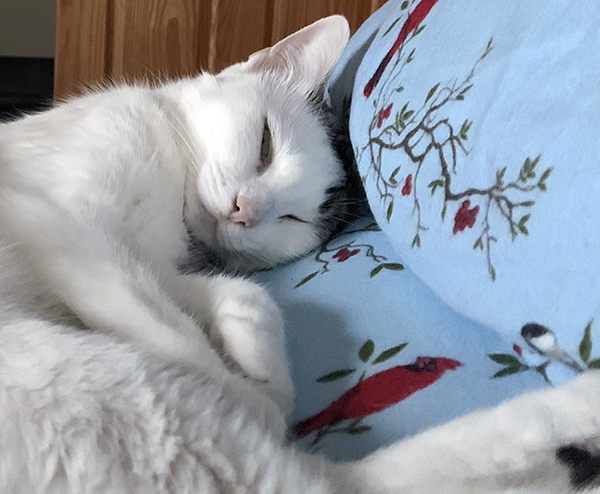
Understanding Cat Behavior
Cats exhibit a range of behaviors that are deeply rooted in their instinctual habits. Understanding these behaviors is essential to providing a supportive environment for them.
The Role of Play and Hunt
Playtime for kittens and cats is not merely a form of entertainment; rather, it is a critical aspect of their development and well-being. Kittens often engage in frequent, vigorous play, simulating hunting scenarios that hone their natural abilities. Through pouncing, stalking, and the iconic ‘butt wiggle’ before they leap, kittens develop the coordination and skills necessary for catching prey.
Older cats, while less energetic, still exhibit playful behavior. This behavior keeps them alert and maintains their hunting instincts, even if they aren’t required to hunt for food. A scratch post or interactive toy can serve as an adequate substitute for live prey, providing the necessary stimulation for a domestic cat.
Sleep as a Defensive Mechanism
Sleeping for extensive periods is a behavior cats have inherited from their ancestors. Predators do not need to be constantly on the hunt, and sleeping helps conserve energy for when a cat needs it most—for hunting and evading natural predators. When cats sleep, they often choose spots that are secure and allow them to remain somewhat alert to potential threats. This defensive mechanism is evident in the way many cats choose to sleep in a curled-up position, known as the loaf, which allows for quick escape.
Communication Through Sleep
Cats communicate not only through vocalizations such as meows and purrs but also through their sleep patterns and positions. When a cat feels safe and trusts its environment, it may sleep in a more vulnerable position, such as on its back with its belly exposed. This is a strong signal of trust to their guardian. In multi-cat households, cats might sleep together as a form of social bonding, which can indicate a harmonious relationship between the cats.
The duration and quality of sleep can also change with age. Kittens and older cats tend to require more sleep, upwards of 18-20 hours, to support their growth and overall health. Changes in a cat’s typical sleep behavior or patterns can be a sign that they may require medical attention, and cat parents should be attuned to such changes.
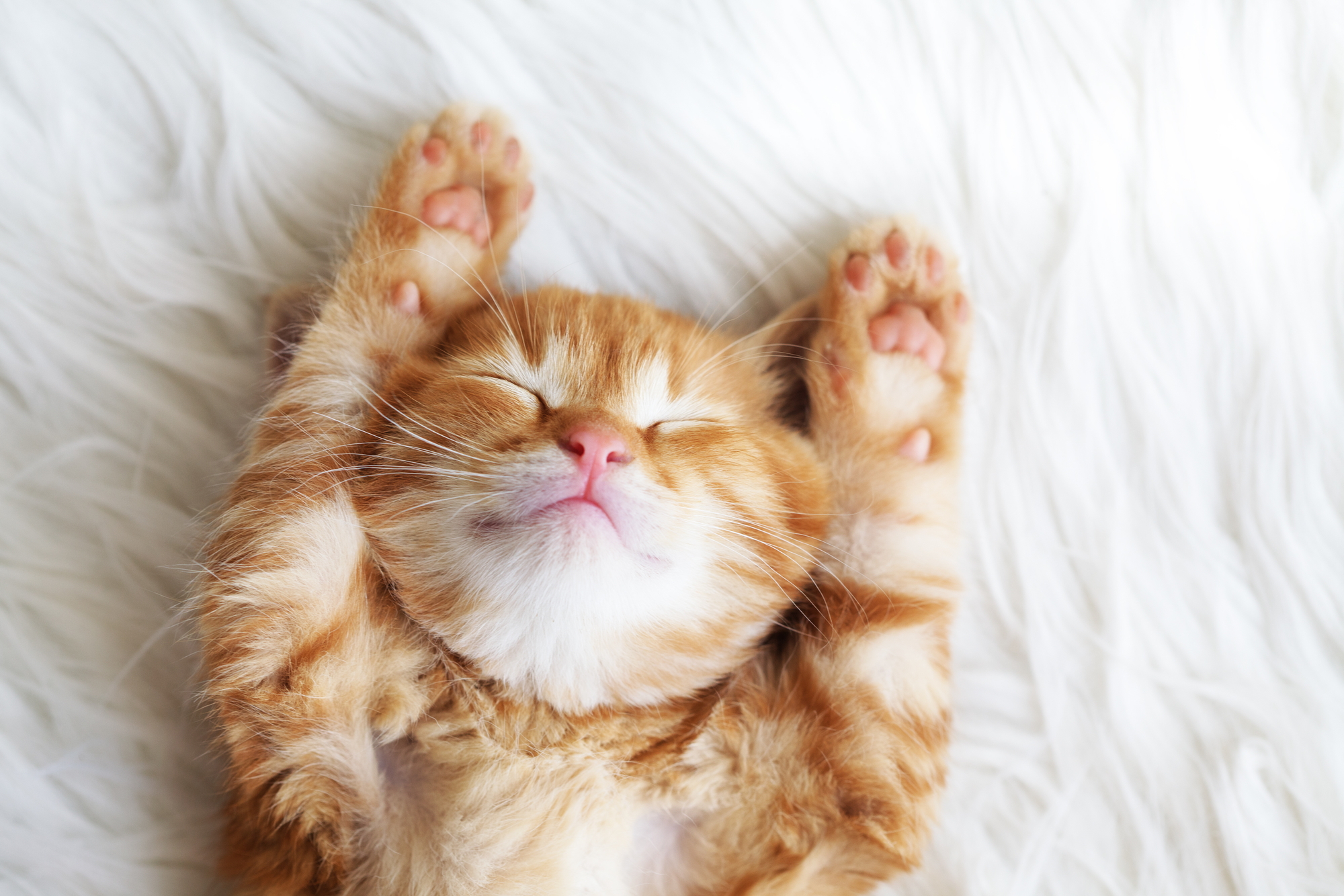
Enhancing Your Cat’s Sleep Quality
Proper sleep quality ensures that a cat maintains a healthy, energetic lifestyle. By focusing on creating a serene environment, encouraging suitable activity levels, and keeping up with health checks, cat parents can contribute significantly to their feline’s well-being.
Creating a Comfortable Environment
A cat’s sleeping area should be quiet, warm, and secluded from high-traffic areas of the home. Cat beds or soft blankets placed on a sofa or in a cozy nook can entice a cat to rest there. Litter boxes should be positioned away from the sleeping zone to avoid disturbances. Parents should also ensure the sleeping area is free from drafts and direct sunlight that might overheat the cat during its slumber.
Appropriate Activity Levels
Cats require a balance of rest and activity to remain healthy. Integrating toys and playtime into a cat’s daily routine can help them expend energy, making rest periods more restful. Engaging a cat with a variety of cat toys can keep a cat mentally stimulated and physically active. Families should encourage play in bursts throughout the day, aligning with the cat’s natural hunting instincts, which helps maintain a routine that naturally leads to rest.
Regular Health Check-Ups
Scheduled visits to the veterinarian are essential for monitoring a cat’s health. A vet can identify if a cat is sleeping excessively due to being sick or if it’s a natural pattern for a healthy cat. Consistent health checks ensure that any deviations in sleep patterns due to illness are addressed promptly. It’s also an opportunity for cat parents to discuss the optimal sleep requirement for their individual feline friends and receive tailored advice from the vet.
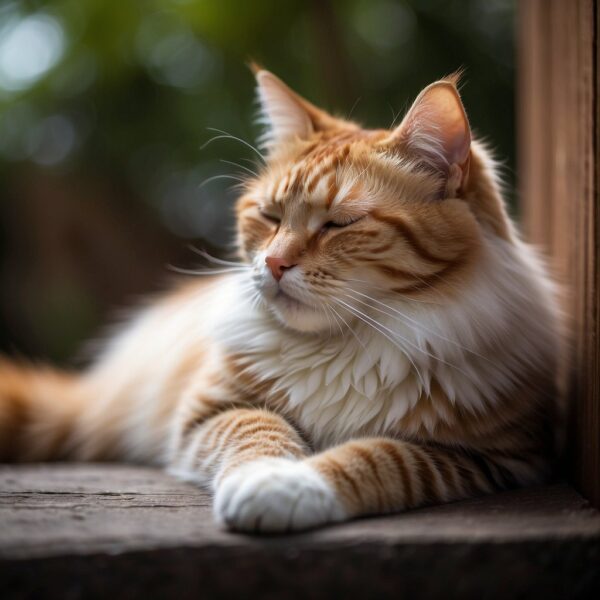
Frequently Asked Questions
In exploring the unique sleeping habits of cats, several common questions arise about their lengthy periods of rest. Understanding these patterns helps to better care for these beloved pets.
Is it normal for cats to sleep all day?
Yes, it is normal for cats to sleep for long periods throughout the day. Cats can sleep between 12 to 16 hours a day, conserving their energy for hunting activities, even in a domestic setting where they aren’t required to hunt for food.
Do older cats tend to sleep more than younger ones?
Older cats do tend to sleep more than their younger counterparts. As cats age, their energy levels decrease, leading to an increased amount of time spent resting. Likewise, kittens also sleep more as they are growing and need more rest.
How might a cat’s sleeping patterns change suddenly?
A cat’s sleeping patterns might change suddenly due to various factors such as stress, illness, or changes in the environment. A significant alteration in how much a cat sleeps can be a sign that warrants a consultation with a veterinarian.
What are the reasons for a cat preferring to sleep curled up in a ball?
Cats may prefer to sleep curled up in a ball to conserve body heat and protect their vital organs. This position is also instinctual and provides cats with a sense of security, making them feel less vulnerable while they rest.
Should I be concerned if my cat sleeps a lot during the nighttime?
Cats are naturally crepuscular, most active during dawn and dusk, so it’s typical for them to sleep at night. However, if there’s a stark change in nocturnal sleeping habits, it could be due to age, health changes, or shifts in the cat’s environment.
Can a cat’s sleeping habits indicate their overall well-being?
A cat’s sleeping habits can indeed be indicative of their overall well-being. Both excessive sleeping and a lack of sleep can signal health issues. Observing deviations from normal sleeping patterns is crucial and might require a veterinary assessment.